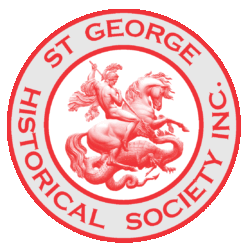Observations made by Mr. Charles C. Brown, Pymble (formerly Councillor and Hon. Treasurer of the Sydney Branch now in Suspense having operating in Sydney from 1912 to 1962) at the gathering held at Wunderlich Ltd. (Modelling Dept.) Redfern on 8th December 1965, arranged by James, Douglas and Associates, Sydney, as to whether he was real or merely a myth.

The Royal Society of St. George, Headquarters, London, many years ago reported that they were quite satisfied there was real evidence for the historical existence of St. George. Legends tended to grow up around all heroes and the essential facts were not in dispute. Europe was full of churches where right down the centuries “St. George has been revered as the epitome of chivalry and as a defender of patriotism and freedom . . . . We are quite content and quite happy about our Saint”. In 1912, one Alice Brewster produced a book entitled George of England our Patron Saint and dedicated this to The Royal Society of St. George.

Quoting from that book, we read “Although George is our Patron Saint, he was not born in England but at Lydda in Palestine about 10 miles from Jaffa or Joppa as it was called in Biblical days, one of the principal seaports of the Holy Land, situated on the Plain of Sharon, so celebrated for its roses, and as this fragrant and lovely flower was George’s favourite, it has become the national emblem of England. He was born A.D. 270 and came of a noble and distinguished family. George’s grandfather was Governor of Cappadocia and his father Governor of Mitylene both of which were districts in Asia Minor under the control of the mighty Emperor of Rome. George entered the Roman Army and by the time he was 20 became known as one of its smartest officers. When only 22, Diocletian, the Emperor of Rome sent him on a mission to England or Britain as then called. It was then through his instrumentality that the Empress Helena the British born wife of Constantius Chlorus was converted to Christianity, and through her, her son, Constantine the Great who later became King of Britain and Emperor of Rome. As the result the course of the whole Roman world in matters of religion was changed and Christianity began to take the place of Paganism. Constantine was born at York and later had the very great distinction of becoming Emperor of Rome and a Christian. George’s stay was not long and his mission completed he returned to Lydda. Shortly after his arrival there the Emperor Diocletian decreed that all professing the Christian religion should be utterly destroyed. At first George determined to stay at Lydda to encourage and strengthen the weak-hearted and timid to stand firm and hold fast to their faith but later decided that as he was well known and liked by Diocletian he would go and see him and intercede with him for the Christians.
It was on this journey of love and devotion made for the sake of his friends and relations to the Court of the Emperor that he met with his celebrated adventure with the dragon and so rescued the maiden that the monster was about to devour. Legend and fairy tale have it that the good knight St. George killed a fabulous beast called a dragon. This could have been a gigantic lizard common in India and Egypt capable of devouring large animals also humans, or possibly a crocodile which could have drifted from New Guinea area (or possibly a Komodo dragon still in existence in the Java islands). Looking at it with our modern views in comparison with those days when there were no guns, it was terrible enough to fight such animals with only a lance and a short Roman sword.

By the town of Berytus (or Beirut as we know it today) is the lake where this animal had taken up its abode. It filled the people of the neighbourhood with terror and dismay as it carried off not only cattle and animals but also human beings. In their ignorance they looked upon it as having been sent by their heathen gods to devour them. Daily offerings of sheep and goats were made as sacrifices hoping to appease the anger of their gods but to no avail. The King of Berytus as headman of the area called the people together and suggested lots be drawn to see who should be given as a human sacrifice to the dragon. To his horror it fell to his daughter Princess Sadra. The people refused the King’s request that somebody else be offered up instead of his daughter as he had proposed the drawing of the lots and they thought, too, being heathens that it fell as it had done by the choice of the gods. The Princess was then dressed in her finest clothes, taken to the sand pit at the lake which was the haunt of the monster and left to her fate. It was whilst in this terrible plight that George rode up on his way to the Court of the Roman Emperor and was told the story. He said he would stay and fight the beast. As they were talking up it came expecting to have an easy prey as usual but George firmly sitting upon his white horse, made his sign of the Cross, charged and slew it. The father of the Princess Sadra wanted George to marry her and remain and live at Berytus but he refused, wanting to continue on to meet the Emperor Diocletian to plead the cause of the Christians. They built a church which they dedicated to Saint George after his martyrdom. George was received by Emperor Diocletian but he refused to spare the Christians and offered George every inducement to forsake his religion yet all in vain. George was put to the most dreadful torture to induce him to forsake his faith and as he refused to do so, he was put to death on 23rd April A.D. 303 at Nicomedeia. Friends and relations of George begged his body from Diocletian and took it back to Lydda for burial, as he had wished. In A.D. 306 Constantine became the first Christian Emperor of Rome. He put an end to the persecutions of the Christians, built a church at Lydda in memory of Saint George and named him patron saint of his own country, Britain, and thus it is that his red cross became a part of the English flag, and his favourite flower the rose, became the national emblem of Britain. Not only did he do this, but he erected over 20 churches to his memory. He also built the magnificent Cathedral of Saint Sophia (Hagia Sophia) at Constantinople (modern-day Istanbul), the finest stained window of which is dedicated to Saint George.
Queen Helena built a church at Glastonbury, in Somerset, which she named after Saint George. Twenty-three years after his martyrdom in A.D. 326, she went to Jerusalem in search of the Holy Cross. Whilst there she caused another church to be erected, and called it also after Saint George, quite close to the Church of the Holy Sepulchre. It is supposed that she succeeded in her quest of the True Cross, and brought a portion of it to England, as a fragment of it is said to be encased in the sceptre of King Edward the Confessor, which our Kings and Queens still use when they are crowned, and which is preserved with the rest of the Crown Jewels in the Tower of London.
This article was first published in the February 1966 edition of our magazine.
Browse the magazine archive.


Well l am fascinated. Really. What a wonderful
account. Of the Romans and the Brits. I had a idea he was more than a soldier who had his head cut of for faith.